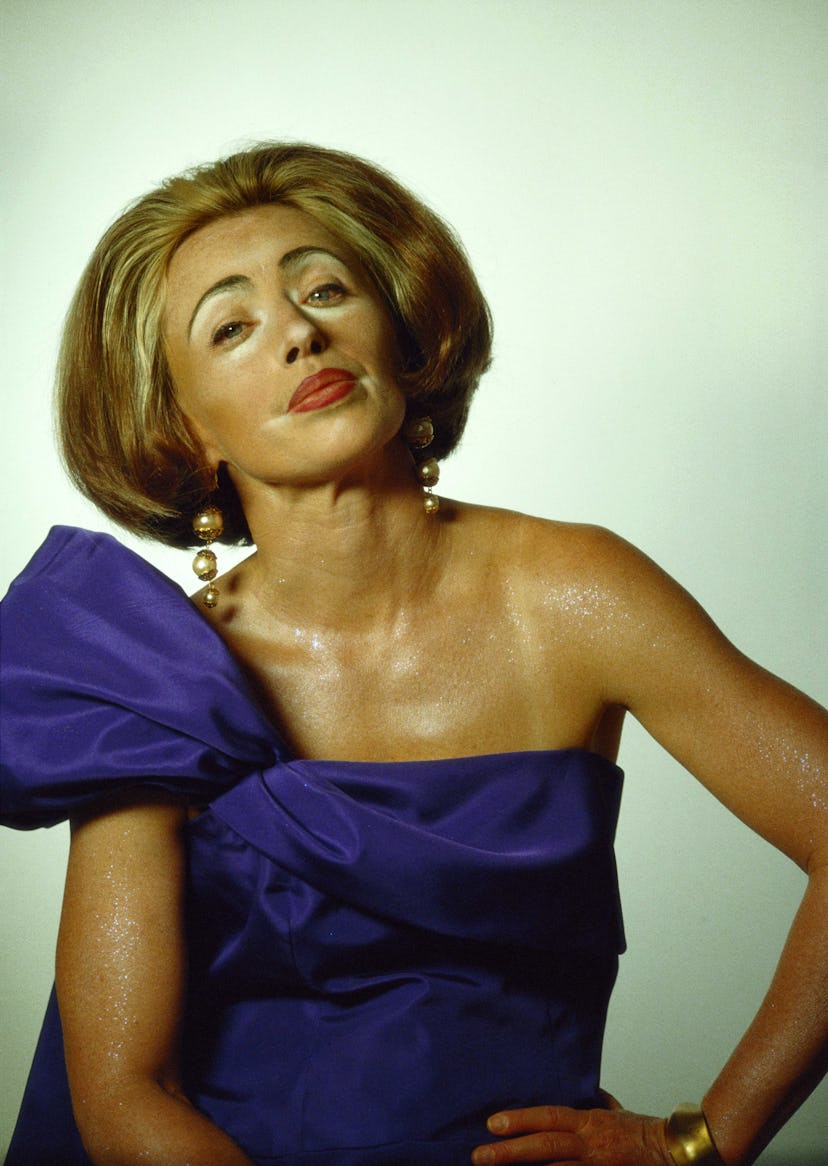Cindy Sherman’s Enigmatic Self-Portraits Take Over the Louis Vuitton Foundation
As a retrospective of Sherman's work opens in Paris, the artist and the curator Suzanne Page reflect on the enduring impact of her body of work.

From a distance, the artist Cindy Sherman could never be mistaken for a recluse, if only for how willing she has been to share her face with us over the years: You’ll find a version of her in almost every European and American contemporary art institution. But when you go looking for her through her idiosyncratically cinematic lens, it’s like tracking down Waldo when he finally decided to ditch the whole striped tee-shirt thing. While Sherman is technically the most sought after self portraitist, her work isn’t really about revealing individual experience or biography, but rather the beautiful and ugly masks we all don throughout our lives.
Cindy Sherman, Untitled #92, 1981 Chromogenic color print 61 x 121.9 cm. Collection Cynthia and Abe Steinberger. Courtesy of the Artist and Metro Pictures, New York © 2020 Cindy Sherman.
Now the entirety of her impressive body of work is getting a Parisian revival. This fall, the Fondation Louis Vuitton has given over the entirety of its Frank Gehry-designed halls to a sweeping retrospective that mixes a traditional linear survey together with a contextualizing group show. “Part of the reason we opened the foundation was to provide opportunities to share the collection with the public,” says the survey’s curator Suzanne Page. “But the reason we are showing Cindy Sherman now is not strictly because of the incredible trove of unseen work the foundation owns, but because the themes that have been coursing through her work from the beginning, such as the aesthetic codification of gender and accelerated commodification of identity, feel more pressing today than ever before.”
Sherman has played seemingly every role there is, from a globular-titted Madonna to a Botoxed Park Avenue doyenne. She seems to relish in these shocking transformations. When it comes to building her own universe, Sherman is an enigma, famously exerting 360 degree control over her images, acting as director, model, makeup artist, lighting guy, set designer. The competing demands of these roles ensures she is at once present and absent in the work. Sherman seems to know her chosen medium’s flaws intimately, like a lover, and therefore knows how to exploit and soothe them at her discretion. If the static truth held in photographs is just a euphemism for death, then Sherman’s work swerves elsewhere towards the bleeding edge of reality, where clarity rides in on the horseback of fiction. Speaking with Sherman earlier this month, I asked if it gets harder to find new roles to play. She answered yes, adding: “It’s more fun to play females, maybe because it’s just a bit easier, but the clothes are more fun and theatrical. Although I’m sure I could try to do theatrical men, too.”
Cindy Sherman, Untitled #582, 2016, Dye sublimation metal print 137.2 x 178.4 cm. Courtesy of the Artist and Metro Pictures, New York © 2020 Cindy Sherman.
Cindy Sherman, Untitled #224, 1990 Chromogenic color print 121.9 x 96.5 cm. Courtesy of the Artist and Metro Pictures, New York © 2020 Cindy Sherman.
An art star born to the Pictures Generation alongside conceptual image-makers like Sarah Charlesworth and Richard Prince, Sherman has maintained a major place in the contemporary art conversation by staying abreast of new technologies and trends, especially as they relate to identity. Sherman’s open mindedness has enabled her to stay flexible. When we got Instagram, she got Instagram and she beat us at it handily. She has collaborated with seemingly everyone from Comme des Garçons to Supreme.
As she was installing the retrospective, Page surprised herself. The mirrored panels suggested by the show’s architects and approved by Sherman placed Page in an awkward emotional space, where it felt like the reality of her reflection could not compete with the realism of the Sherman photographs floating behind her. “It was terrifying to feel in that moment that a picture was more real than I was, but that’s the effect Sherman can have,” Page says.
Cindy Sherman, Untitled #607, 2020, polyester, cotton, wool, and acrylic woven together 112 x 86 inches, 284.5 x 218.4 cm. Courtesy of the Artist and Metro Pictures, New York © 2020 Cindy Sherman.
Those familiar with Sherman’s work will find favorites amongst the 300 selected images, as well as new finds. An entire room is dedicated to the artist’s relatively new tapestry series, in which her portraits take the form of massive wall hanging rugs, evoking at once medieval courts and cold weather tailgating. Page considers these works some of the most haunting of the bunch, for the physicality they introduce. For Sherman’s part, they recall a more contemporary reference: “The weaving was not unlike the pixelation that happens in digital imagery,” the artist says. “It had been on my mind for some time.
The concurrent Crossing Views exhibition, which surfaces work by like-minded artists, helps tease out historical and thematic connections but also looks back at Sherman as an observationalist and avid art collector. “Cindy is a huge champion of young and other artists,” Page says. “It felt important that we make that a part of this show.”
Curbed by Covid’s rolling quarantine, Sherman says she’s eager to return to her regular galleries and museum goings. “I’ve missed seeing art very much during the pandemic,” Sherman says. “I find looking at art, even bad art, to be very informative and inspiring—it helps me to formulate why things work and don’t work.” This new retrospective invites us to join her in this communal dialogue of self discovery.
“Cindy Sherman at the Fondation Louis Vuitton” is on view in Paris through January 2021.